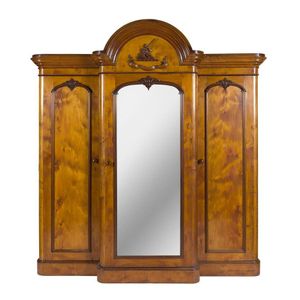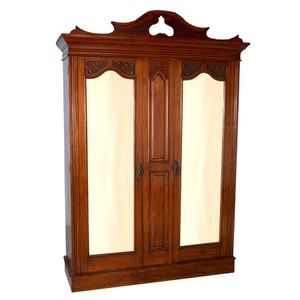Rococo Walnut Armoire with Birdseye Maple Interior
You must be a subscriber, and be logged in to view price and dealer details.
Subscribe Now to view actual auction price for this item
When you subscribe, you have the option of setting the currency in which to display prices to $Au, $US, $NZ or Stg.
- Maple - Maple, native to North America, is a dense heavy timber from light to yellow-brown in colour. It has very little distincive graining unless it is one of the variants such as birds-eye maple or burr maple, so was not used extensively for furniture in 18th and 19th century, where cabinetmakers and designers preferred timbers with more distinctive features such as mahogany, walnut, rosewood and oak.
Birds-eye maple has a seres of small spots linked by undulating lines in the grain, is highly sough and is used as a decorative veneer. Burr maple has larger and irregular grain swirls than birds-eye maple. - Veneers - Veneers are thin sheets of well-figured timber that are glued under pressure to the surface of a cheaper timber for decorative effect, and then used in the making of carcase furniture.
Early veneers were saw-cut so were relatively thick, (up to 2 mm) but is was realised that saw cutting was wasteful, as timber to the equivilent of the thickness of the saw was lot on each cut.
A more efficient method was devised to slice the timber, either horizontally with a knife, or in a rotary lathe.
Flame veneer, commonly found in mahogany or cedar furniture, is cut from the junction of the branches and main trunk. So-called fiddleback veneers, where the grain is crossed by a series of pronounced darker lines, is usually cut from the outer sections of the tree trunk.
During the 17th and 18th centuries, and in much of the walnut marquetry furniture made during the latter part of the 19th century, the veneer was laid in quarters, each of the same grain, so that one half of the surface was the mirror image of the other.
The use of veneer allows many other decorative effects to be employed, including stringing, feather banding, cross banding, and inlaid decorative panels in the piece. The carcase over which veneer is laid is usually of cheaper timber such as pine, oak or, sometimes in Australia during the first half of the 19th century, red cedar.
The important thing to remember about veneers is that prior to about 1850 they were cut by hand, and were consequently quite thick - ranging up to about 2mm deep.
From the mid-19th century veneers were cut by machines and were almost wafer-thin. This is a critical point when trying to judge the approximate age of veneered furniture.
This item has been included into following indexes:
Visually similar items

Vitrine: French kingwood & rosewood with mirror back interior, electrified for display. Height 248 cm, width 108 cm, depth 47 cm.

A French kingwood and walnut vitrine, 20th century, 154 cm high, 76 cm wide, 37 cm deep

A magnificent three door wardrobe, solid huon pine with break front and carved blackwood armorial crest within a domed pediment, circa 1875, 246 cm high, 230 cm wide, 70 cm deep. Provenance: Originally the property of William M'Millan of Landcox, Union Str

Anthony Hordern & Sons Queensland maple wardrobe early 20th century, with keys, brass makers plaque inside door, 236 cm high, 164 cm long, 56.5 cm deep
